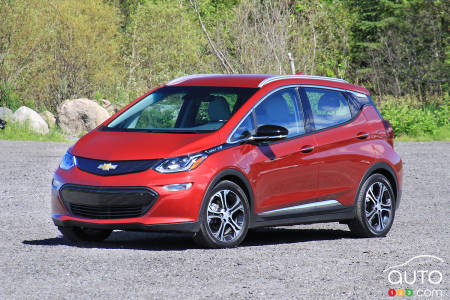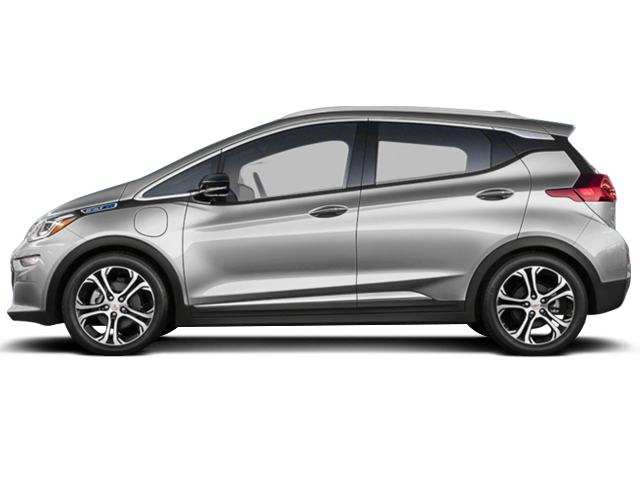History sometimes unfolds in mysterious ways. You may remember, for instance, the sad story of GM’s EV1, a promising late-1990s project that soon crumbled into dust. Its tale was told in forceful fashion by filmmaker Chris Paine in his 2006 documentary “Who Killed the Electric Car?” Yet today, the automaker so witheringly vilified in that film has become the defender of green cars, and the first to launch a truly affordable electric-powered car that offers practical range. Is it a form of redemption for GM, a gesture to help save the planet, or it is a vulgar, opportunistic business decision? Opinions vary…
In any event, between January and July of this year, 983 Canadians chose the Bolt when came time to buy a vehicle, and demand continues to grow. Of course, these numbers mean the Bolt remains a rare sight on our roads; to put them in perspective, consider that during the same period Chevrolet sold over 15,000 of its Cruze in this country. That the latter model is two to three times less expensive plays a part to be sure. What’s more, dealerships keep tons of them in stock, and they still correspond much more closely to what the average consumer looks for in a car. No one buying a Cruze has to worry about its range, because there are more gas stations around than you can shake a stick at, and it only takes about five minutes to fill up. With an electric car, on the other hand, the sales pitch as most consumers hear it runs as follows: it’s expensive, it won’t go very far on a charge, and recharging it takes forever.
The small new Chevrolet is doing its part to change that perception. Granted, it’s still not exactly cheap: the base price of the Bolt LT is $43,095, making it the costliest item in the entire Chevrolet catalogue (including the Impala Premier). That total does not include $1,950 in transportation and preparation fees, either.
But this MSRP does not include the discount consumers get via government incentives, currently offered in three provinces. If you live in Quebec ($8,000 rebate), Ontario ($14,000) or British Columbia ($5,000), then the price for the base model of the Bolt drops to $38,582, $32,582 and $41,582, respectively. The Premier trim, meanwhile, costs $50,045 before incentives, or $5,000 more than the base model. The manufacturer justifies the price difference between the two trims by pointing to the Premier’s boosted roster of equipment and features, including several external cameras, display of backup camera images on the rearview mirror, leather upholstery and a number of drive-assist features like blind-spot and rear-transversal-traffic object detectors. Whichever trim you do choose, if you want a colour other than the standard Summit White or Silver Ice Metallic, you’ll have to fork over between $495 and $595 more.
Within market norms
So does all this make the Bolt over-priced? At $38,582 (in Quebec), the LT model is less expensive than the humblest Mercedes-Benz C-Class sedan, of which the German automaker has sold 6,000 units since the start of the year. Find the comparison inapt, a case of comparing apples and oranges? Then consider the B-Class – more precisely the B 250 – which the manufacturer sold 3,000 units of in the same period. This small Mercedes, available starting at $35,900, has essentially the same dimensions and interior cabin space as the Bolt. So if you feel that the Chevy is too expensive, ask those B-Class buyers if they consider their car unreasonably priced.
If we take the comparison further, we see that the front-wheel drive B 250 features a turbocharged 4-cylinder that consumes on average 8.3L/100 km and takes it from 0-100 km/h in 6.3 seconds. The Bolt, also a front-wheel drive, is powered by a 200-hp electric motor that can accelerate from a stop to 100 km/h in 6.5 seconds and has a stated range of 383 km. The Mercedes’ 50-litre tank (which costs roughly $55 to fill up, based on a fuel-pump price of $1.10) allows it to cover around twice that distance before refueling. Based on some estimates that have been done, the Bolt costs four times less to use. It also won’t necessitate paying up the periodic mechanical maintenance costs that the Mercedes will inevitably incur. No oil changes, no engine or transmission repairs, etc.
To be sure, driving an electric car naturally implies making certain adjustments to one’s driving behaviour. Plugging the thing in regularly is a must, for example. But really, this is something we’ve already been trained to do, with our smartphones. It’s also necessary to become well-acquainted with the various ways of recharging the car’s 60 kWh lithium-ion battery: the slow-charging standard residential 120V plug (level 1), the 240V charging station (level 2) that gets the battery fully recharged in around nine hours, and lastly the 400V+ supercharging station (level 3). It can give the battery 80% of its full charge in one hour, or give it enough to cover around 145 km in 30 minutes. This is, at first glance, mighty complicated, but as with many such things familiarity comes quickly. In fact, by getting into the habit of plugging the car into a power source regularly (when arriving at work or at home), owners will find they rarely get anywhere near a totally rundown battery.
Two packages for Canada
In most parts of Canada the standard version of the Bolt comes with two equipment packages that are optional for buyers in the United States. As well, the recharging system of the car is compatible with supercharging stations, which in Quebec gives full access to the entirety of the province’s public network of recharging stations (there are currently over 1,250 stations).
In addition to self-sealing Michelin Energy Saver all-season tires, the Bolt comes with a compressor that uses a liquid tire sealant to temporarily plug any hole up to 6 mm. In the absence of a spare tire, which the Bolt does not come with, the compressor allows drivers to travel up to 160 km to get to a service centre.
One of the most attractive things about this electric car is the driving experience it offers. The Bolt has precise steering and a smooth suspension that prevents roll. What’s more, its engine can generate 266 lb-ft of torque as soon as it’s called upon, and take the vehicle from 0-100 km/h in just 6.5 seconds – the same as the 2.0L, 4-cylinder turbo of the B 250. This is quite impressive for a family ride. Compare for example with the similarly dimensioned Honda Fit, which takes close to 9 seconds to get to 100 km/h with its 1.5L, 138-hp naturally aspirated engine, even though it weighs some 500 kg less.
The Bolt is also equipped with a regenerative braking system, which harnesses the energy produced in slowing and braking to recharge the battery. When in Drive driving mode, it kicks in as soon as the accelerator is released. In Low driving mode, an increased braking effect produced by the engine turning as a generator increases the rate of energy recovery.
The driver can also use the Regen on Demand mode, activated by pulling a paddle on the steering wheel and which converts more energy into electricity. However, when it’s used in combination with the Low driving mode, the engine’s torque resistance becomes so elevated that it’s no longer even necessary to apply the brake pedal to slow down or stop the car. This is a little disconcerting at first, but as the system modulates itself admirably well you should get comfortable with it quite quickly. The manufacturer calls it “one-pedal driving”, and it’s highly practical in a host of different situations, for example when in rush-hour traffic. Chevrolet claims that the system increases the car’s range by up to 5% in comparison with driving in Drive mode!
A welcoming interior
The interior of the Bolt, which has a flat floor, can easily accommodate four average-sized adults. And despite the resolutely modern design of its dashboard, the instrument panel is simple to use. Its adaptable trunk, meanwhile, offers cargo volume similar to that of a Trax or a Fit. Ideal for getting that late-teen off to college!
In fact, that late-teen will feel right at home in the Bolt. GM is tailoring the car to attract a pioneering type of consumer, the kind of hyper-connected and tech-savvy motorist who is always among the first to adopt new technologies. That this demographic has already foregone the need for a GPS, for example, explains its absence from the features included in the Bolt.
In the view of GM it’s simply not needed, since drivers will prefer accessing their favourite GPS smartphone app via the 4G LTE capacity of the infotainment system, to use. Let’s hope that said drivers will have equipped themselves with a generous data plan! In any event this won’t be their biggest concern. As proud early adopters, these motorists will have spent time and effort developing strategies to minimize energy consumption, and even more crucially to finding access to convenient places they can recharge at. Of course, it’s a safe bet that many of these motorists will also have another vehicle – a gasoline-engine-equipped one – sitting at home. The fact is, at present an electric-powered car is still first and foremost an excellent choice for a household’s second vehicle. This is especially so for the Bolt, which offers ample range and a positive driving experience. By its qualities it also manages to inch us closer to that future time when all of a Canadian household’s vehicles will be electric.








